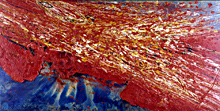2d
アンフォルメル旋風
Art Informel Sensation
【本文確定】
1956年11月、東京日本橋の高島屋百貨店で「世界・今日の美術展」が開催されました。同展には外国人作家約40名と日本人作家約60名による多種多様な同時代絵画が展覧されましたが、特に注目を集めた一定の傾向がありました。それはミシェル・タピエが「シニフィアン・ド・ランフォルメル」と呼んだ外国人作家たちの作品で、具体的にはフランス人ジャン・フォートリエ、ジャン・デュビュッフェ、ジョルジュ・マチュー、アメリカ人サム・フランシスほかによる非定形(フランス語でアンフォルメル)の抽象絵画でした。激しい筆致と厚塗りの粗い質感が特色でした。
その影響は翌1957年2月の第9回読売アンデパンダン展に早くも現れ、瀧口修造は次のように記しました。「昨年の『世界・今日の美術展』で紹介されたアンフォルメル絵画の投じた影響力もおおいがたい。手放しの模倣もある。無審査のアンデパンダンなのだから長所も現われる代わりに、こういう弱点が多少とも露呈されるのは覚悟しなければならない」*2d1。日本に紹介されたアンフォルメルの衝撃とその追随、それが「アンフォルメル旋風」です。
同1957年夏以降は、ジョルジュ・マチューが日本橋の白木屋百貨店のショーウィンドーで派手な身振りの公開制作を行ったのを始めとして、サム・フランシスや、渡仏して5年になる今井俊満ほか、アンフォルメル作家の来日と展覧会が相次ぎました。ミシェル・タピエ自身も来日して展覧会や討論会の企画を行い、各地の新人のアトリエを訪問する等、精力的に活動しました。
「アンフォルメルってなんや?」と言って勉強を始めた「具体」のメンバーたちも、急速にミシェル・タピエの陣営に取り込まれました。作風はアンフォルメル様式へと変貌し、すなわち、それまで逸脱していた絵画という形式に回帰しました。1958年4月には大阪の高島屋百貨店で「新しい絵画世界展/アンフォルメルと具体」が行われました。そして1958年10月にニューヨークのマーサ・ジャクソン画廊で「具体ニューヨーク展」が開かれたことを皮切りに、以降は世界中でミシェル・タピエの企画による「具体」の展覧会が行われるようになりました。
この時期にアンフォルメルに染まったのは読売アンデパンダン展の出品作家や「具体」のメンバーたちだけでなく、既存の公募団体作家を含む、日本中のほとんどの画家たちでした。それを恥ずべき西洋追随劇と見ていた池田龍雄は、次のように証言しています。「焼け野が原を通り抜けた後でも、明治以来しみついたこの国の舶来コンプレックスは根強く残っているらしく、フランス製のその新しい美学は、まるでやけぼっくいに火がついたとでもいうか、以来、日本美術界の最前線に思いがけない勢いで広がったのである。(中略)タピエに扇動されたかの如く、あたふたと自分の絵をアンフォルメル風に塗り替えてゆく多くの同世代の画家たちの姿を見て、何か寒々とした気分になったのはわたしだけではない」*2d2 *2d3 *2d4 *2d5。
ところで、前出の瀧口修造による読売アンデパンダン展評には、続けて次の記載があります。「私は必ずしもこんどの傾向をアンフォルメル絵画とむつかしく結びつけて考えるまでもなく、むしろ方向を求めて鬱積した表現意欲がまず行動に直結しているので、アンフォルメルはその機縁になっているにすぎないと思う」。これは「アンフォルメル機縁説」と呼ばれた考え方で、西洋追随であるとして否定的に切り捨てるのではなく、鬱積していた表現意欲を肯定的にとらえる立場でした。
記録によれば、この1957年の第9回読売アンデパンダン展には九州派の作家たちが初出品したほか、(ミシェル・タピエの陣営に取り込まれる前の)芦屋の「具体」、名古屋の「アルファ芸術陣」、東京の「ラ・ヴィ」ほか、それぞれの地域に根ざした前衛運動集団の登場が目立ったとされています。もし、瀧口修造のアンフォルメル機縁説が、こういった前衛運動集団の登場に触発されて発想されたのだとするならば、アンフォルメル旋風の担い手には次の2通りあったということができるでしょう。一つ目は既存の公募団体作家等、池田龍雄を寒々とさせた西洋追随者たちで、彼らにとってアンフォルメルは追随すべき様式のことでした。二つ目は地域に根ざした前衛運動集団等、瀧口修造にアンフォルメル機縁説を発想させた表現者たちで、彼らにとってアンフォルメルは以前から鬱積していたエネルギーを発露する機縁にすぎませんでした。そして実際、後者のなかから、アンフォルメルの影響をすぐに捨て去り反芸術へと邁進する作家たちが育つこととなります。
1958年の第10回読売アンデパンダン展はアンフォルメル旋風の一つの極点で、1500点以上の大量出品と、新人の大量出現がありました。数年後に反芸術と呼ばれることとなる前衛作家たちは、アンフォルメル風に絵の具を盛り上げるだけでなく、一歩進んで異物を画面に貼り込み始め、結果として画面が分厚く出っ張ったと言われています。
In November 1956, "Exposition Internationale de l'Art Actuel" was held at the Nihonbashi Takashimaya Department Store in Tokyo. Showcasing contemporary paintings of more than 60 Japanese and 40 oversea painters, the exhibition created a great sensation by introducing painters whom Michel Tapie called "signifiant de l'informel." More specifically, Jean Fautrier, Jean Dubuffet or Georges Mathieu from France and Sam Francis and others from the USA were featured, whose formless abstract paintings were characterized with violent brushstrokes and thick and coarse texture.
Its influence on Japanese painters appeared as early as in the following year, at the 9th Yomiuri Independent Exhibition in February 1957. TAKIGUCHI Shuzo 瀧口修造 described it as follows; "What is undeniable is the influence of works of the art informel shown at 'Exposition Internationale de l'Art Actuel' last year. There were even blind imitations. As the no-jury style of the independent exhibition can appear as weakness, we must be prepared for such demerits in return for merits." The shock and followers that introduction of the art informel to Japan brought about bacame what to be referred to as "art informel sensation."
From the summer of that year 1957, painters of the art informel came to Japan and held exhibitions one after another. It began with Georges Mathieu's flamboyant painting demonstration in a display window of the Nihonbashi Shirokiya Department Store, then followed by Sam Francis and, among others, IMAI Toshimitsu 今井俊満 who had been in France for five years. Michel Tapie himself also came to Japan, actively organizing exhibitions or panel discussions and travelling everywhere to visit newcomers' ateliers.
Members of Gutai too, having wondered "what the heck is that 'art informel'?" and tried learning it, soon became involved in Michel Tapie's camp. Their style changed into that of the art informel, that is, going back to the painting from which they had deviated. Then, since "The New World of Paintings Exhibition / Art Informel and Gutai" at the Takashimaya in Osaka in April 1958 and "Gutai Exhibition in New York" at Martha Jackson Gallery in New York in the following October, a series of exhibitions featuring Gutai came to be organized by Michel Tapie all around the world.
Those who were infatuated by the art informel at that time were not only artists participating in the Yomiuri Independent Exhibition and Gutai members, but it was rather almost all the painters in Japan, including those of the established contest-organizations. IKEDA Tatsuo 池田龍雄, who regarded this situation as a shameful play to obey the West*2d1 *2d2 *2d3, stated: "The inferiority complex toward the foreign-made has permeated this country since the Meiji period, and it seems to have deeply rooted even after passing through the ashes of the devastating war. The new made-in-France aethetic spread out over Japanese art circles in a surprising speed, say, as if one's lost love somehow rekindled...... It was not myself alone who felt disheartened by seeing many painters of my same generation rushing to modify their own paintings, as if incited by Tapie, hastily into the art informel-like."
On another note, the above-mentioned review of the Yomiuri Independent Exhibition by TAKIGUCHI Shuzo 瀧口修造 contained the following statement: "I do not necessarily think of this trend as being specifically connected with the art informel paintings. Rather, there would be a pent-up desire that had sought somewhat courses for expression, which directly resulted in this movement, thus I think the art informel was nothing more than a trigger." This stance came known as "the art informel trigger theory," giving positive attention to the repressed desire for expression instead of just condemning it as mere obedience to the West.
According to several records, this 9th Yomiuri Independent Exhibition in 1957 was a landmark event where Kyushu-ha made their first appearance among other emerging avant-garde groups based on their own regions, such as Gutai from Ashiya (before being categorized by Michel Tapie), "Alpha Art Camps" from Nagoya or "La Vie" from Tokyo. If the emergence of those avant-garde groups had helped TAKIGUCHI Shuzo 瀧口修造 to conceive the art informel trigger theory, it can be said that atrists taking part in the art informel sensation were divided into the following two categories. The former was the followers of the West who made IKEDA Tatsuo 池田龍雄 feel disheartened, such as members of the established contest-organizations, for whom the art informel was a style to imitate and follow. The latter was the artists who prompted TAKIGUCHI Shuzo 瀧口修造's trigger theory, such as groups of regional avant-garde movements, for whom the art imformel was at most a trigger to let their long-stifled energy express out. In reality, artists departing from the influence of art informel toward anti-art were to emerge out of the latter.
The 10th Yomiuri Independent Exhibition in 1958 was a peak of the art informel sensation, which witnessed vast hordes of emerging newcomers and massive exhibits of more than 1,500 works. Some avant-garde artists showed a tendency to thicken the canvas, not only by piling layers of paints but also going a step further to heap up objects foreign to the painting, coming to be called anti-art a few years later.
